Sanosil



















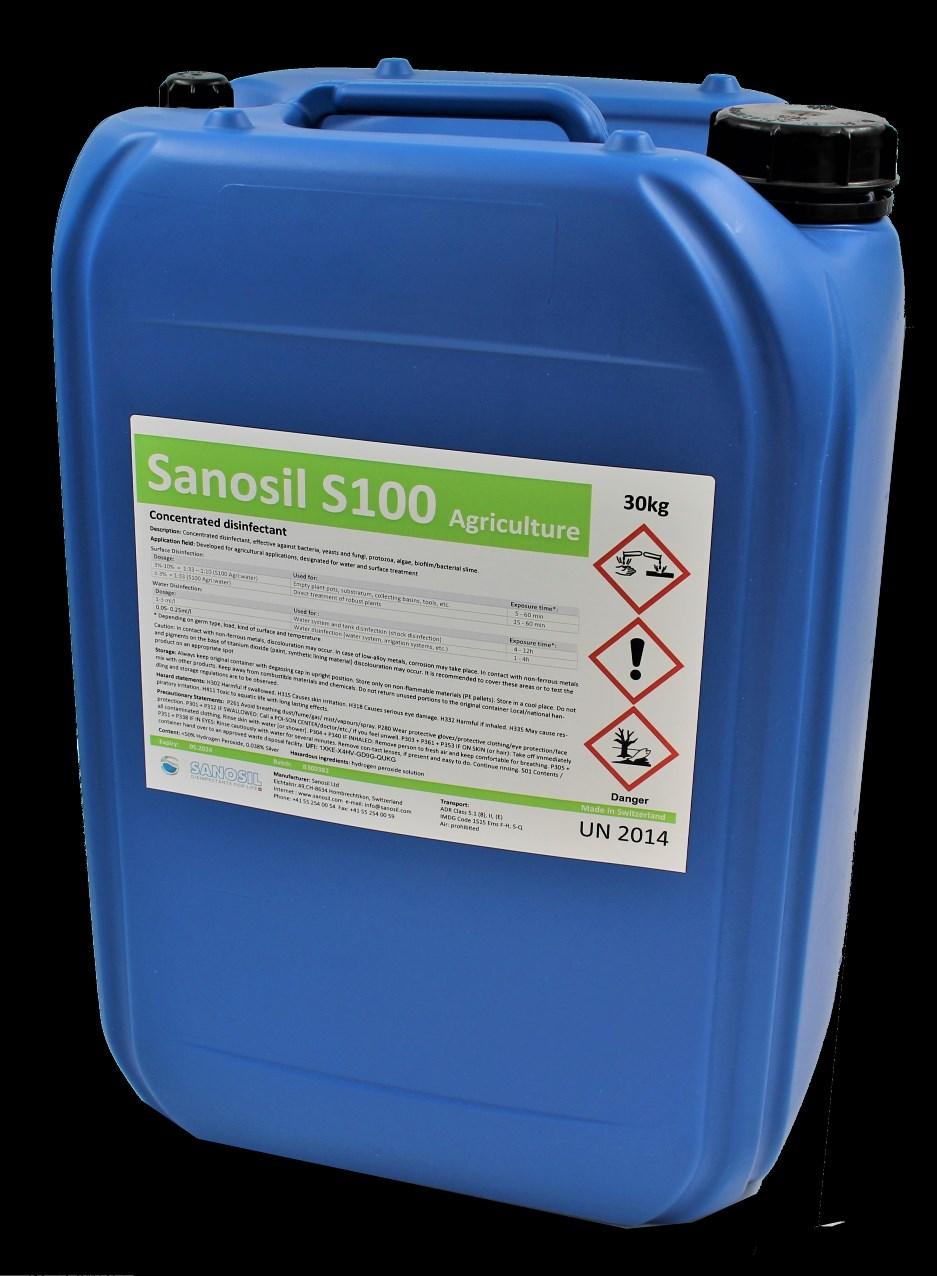
Disinfectant











disinfecting
Effective
Highly
Very
Straightforward
Multiple

With
The

Shelf

High
SANOSIL




Sanosil S100 is a multifunctional, highly concentrated disinfectant for agricultural applications. It is suitable for disinfecting water, pipes and tanks as well as for treating surfaces and equipment. S100 is exceptionally powerful against biofilms, which makes it the preferred product for eliminating and preventing germs and blockages in irrigation systems.

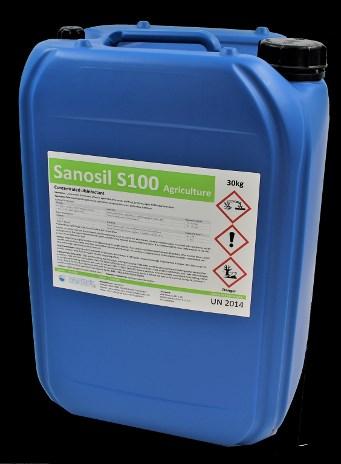
Hydrogen peroxide is used as the active ingredient. It is also stabilised and its disinfecting effect is catalytically enhanced several times over by adding a minimal amount of silver ions. This process can increase the disinfection effect by up to 800%.
After application, hydrogen peroxide also completely decomposes into water and oxygen. The minimal amount of silver remaining after the peroxide has broken down inhibits the multiplication of germs and has additional conservation properties, especially in water systems.
PRODUCT TYPE Concentrate (hazardous substances)
SUITABILITY

Water disinfection (water treatment, irrigation systems, tanks)


Surface disinfection (Rooms, work surfaces, flooding desks, pots and equipment, etc.)

Substrate treatment (Treating plant substrates)
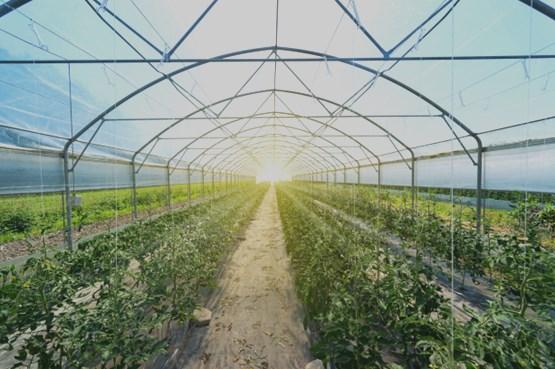
Biofilms (slimy deposits of bacteria, fungi and protozoa) not only cause blockages in irrigation systems. They also protect potential plant pathogens from disinfection measures. In the case of serious biofilm growth, disinfection with conventional products is generally useless, because the biofilms cannot be reliably removed.
In addition, the bacteria are often in a "VBNC" state. (VBNC = Viable But Not Culturable). This skews performance controls and offers a false sense of security.


In contrast, Sanosil can effectively eliminate and prevent both biofilms and VBNC germs.


EFFECTIVE AGAINST (Depending on concentration) bacteria, yeasts, fungi/moulds, viruses, spores
SHELF LIFE 2 years
CONTAINS 50g/100g hydrogen peroxide, 0.35g/100g silver as the catalyst
SANOSIL AG
The oxygen (1O2/ O2) released by the hydrogen peroxide attacks the cell walls of the microorganisms. The process of oxidation (cold combustion) denatures and destroys them.

The effect is supported by silver ions, which enhance the effect of the peroxide in a catalytic process. They also block the metabolism (where applicable) and the ability of the germs to multiply.



CH 8634 Hombrechtikon
mail: service@sanosil.com


sanosil.com
Switzerland


Shock disinfection is applied as initial treatment for acute contamination. It dissolves and eliminates biofilms and cleans the system of deposits.
Although we strongly recommend a proportional dosing device or, even better, a dosing pump for the regular application of Sanosil S100, a contaminated system can also be disinfected without special equipment. A mixing container and a pump as well as protective equipment for your eyes and skin will suffice.
Mix Sanosil S100 (B) with water in a container (C) Dosage: 1 ml per litre of water (=1000 ppm).

Pump the disinfectant solution into the system to be disinfected (A) using a pump (D) and fill it completely. To do this, open all taps until disinfectant solution flows out. Test with measuring strips. Prevent dead water zones and air pockets.
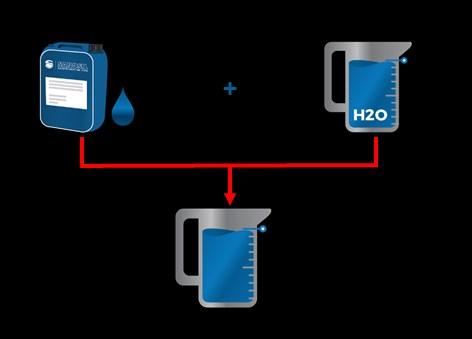

Note: observe the following if drinking water tapping points are also connected to the system. During disinfection, block the corresponding tapping points that are in regular use or add the appropriate warnings.

Allow the disinfectant solution to take effect for at least 4 hours (safety margin due to possible biofilms).
Occasionally open the water tapping points slightly so that fresh disinfectant solution can flow in and a uniform concentration can be maintained in the system.

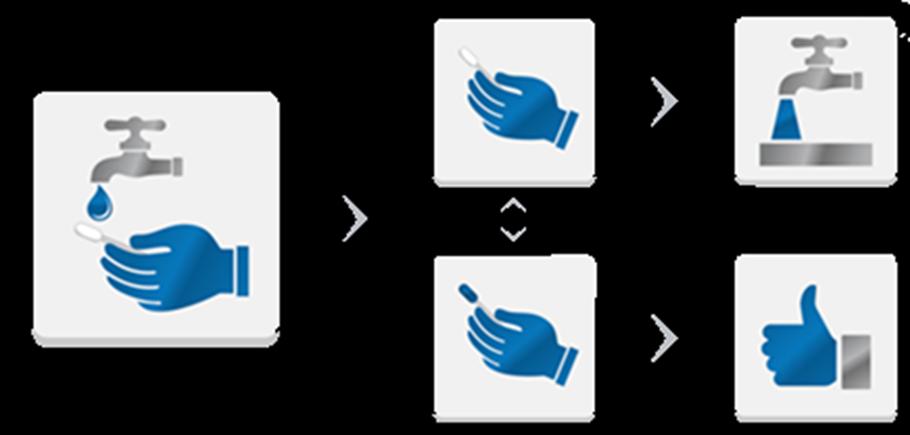

Flush the system. If necessary, check for disinfectant residues using measuring strips.
1ml of S100 1 litre of water

Sanopstrips 200 measuring strips, which react to Sanosil S100 by turning blue, are suitable for detecting Sanosil in water.
Dosage for shock disinfection: 1 ml of S100 per 1 litre of water = 1000 ppm
We recommend using a proportional dosing pump for regular applications.
SANOSIL AG • CH 8634 Hombrechtikon • Switzerland
E mail: service@sanosil.com www.sanosil.com



An increased dose of disinfectant is added sporadically to the contaminated system during a shock disinfection procedure. This is carried out for acute eradication of germs and the removal of biofilms.
Maintenance disinfection involves the continuous application of small doses of disinfectant. The objective here is to prevent or inhibit the formation of new germs and biofilms.
Combining the two methods is ideal.
Shock treatment is used for basic disinfection in contaminated water systems, such as pipes and tanks with biofilm formation.
1.
2.
3.
disinfectant solution: Dosage: 1 ml of S100 per litre of water (=1000 ppm)
fill the pipes/tanks with disinfectant solution

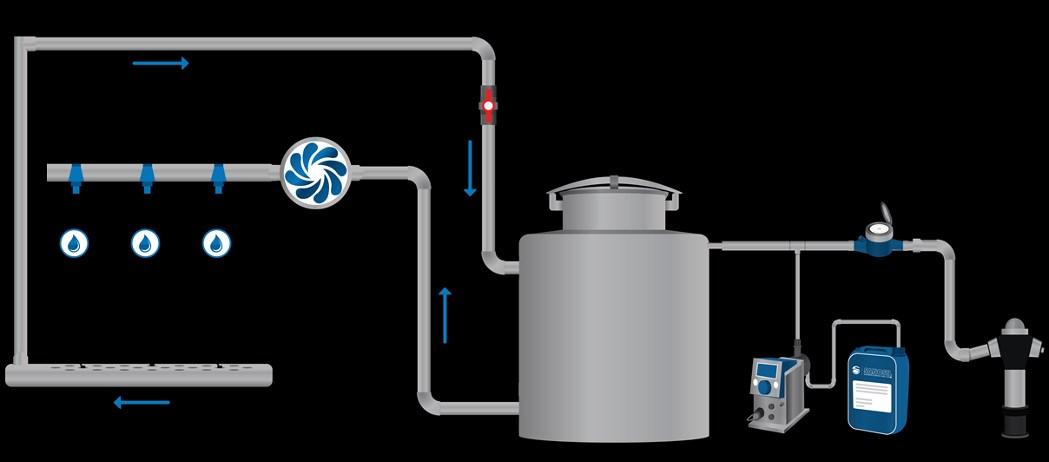
it work for at least 4 hours (preferably overnight)
4.
disinfectant

The continuous treatment of the water or nutrient solution following shock dosing prevents biofilm from forming again. In case of return systems, it also prevents the spread of plant pathogens, such as root rot. It is suitable for both top feeders and flood desks. Positive side effect: the oxygen split off by the hydrogen peroxide promotes root formation.


Dosage: approx. 0.05 ml of S100 per litre of water (50 ppm)
The objective is to achieve an average content of 20 30 ppm of S100 in the return flow. If the value is too low, increase the dosage as necessary.

Adding a small amount of Sanosil S100 to a clean system prevents biofilm from building up as well as blockages caused by bryozoans and algae.

Dosage: 0.03 ml of S100/litre of water (30 ppm), measured at the spray nozzle.
(Tip: a short term increase in dosage at the end of an irrigati-





Surfaces, such as work tables, flooding desks and equipment, etc. can be effectively disinfected by spraying with a freshly mixed solution of Sanosil S100. Spray application is possible using a cold fogger, a low pressure sprayer (pump or compressed air) or (as a special case) a thermal fog generator.
The following must be observed:
A: The cleaner the sprayed surfaces, the more effective Sanosil S100 will be.
B: If larger quantities of aerosols are produced, appropriate protective equipment for the eyes and respiratory tract must be worn.
Recommended dosages:
3% S100 (1 part S0100, 33 parts water)
(for standard disinfection tasks)
10% S100 (1 part S0100, 9 parts water) (for highly contaminated surfaces, controlling moulds and algae)
Fill a cold fogger with disinfectant solution and spray the surfaces. Consumption approx. 30 – 50 ml per m2
Important: we strongly recommend using an ABEK P3 protective mask when working with cold foggers.



Pressure sprayers are ideal for smaller, targeted applications.
3% S100 (1 part S0100, 33 parts water) (for standard disinfection tasks)
10% S100 (1 part S0100, 9 parts water) (for highly contaminated surfaces, controlling moulds and algae)
Disinfectant solution: consumption: approx. 50 ml per m2

To treat certain fungal diseases, such as powdery mildew and Fusarium infections, plants can also be sprayed directly with up to 3% Sanosil S100 solution.


For acute powdery mildew infestation: approx. 50 ml/m2 of area
Treatment for 3 days in a row.
Controlling Fusarium Oxisporum: add 0.7 1 ml of Sanosil S100 per litre of water (= 700 1000 ppm) to the irrigation water. (See also previous page)
Sanosil S100Sanosil S100 is a highly concentrated disinfectant and causes skin irritation as well as serious eye damage in its concentrated state. Always wear protective gloves and goggles when preparing Sanosil solutions.

Before using Sanosil S100, read and follow the instructions on handling, storage and transport in the safety data sheet.


Ideal for controlling airborne mould spores. Mix fogging solution (enough for approx. 100 m3):
150 ml of S100 + 850 ml of water + (optional) 70 ml of fogging agent (PEG).
Close doors, windows and hatches. Fill a suitable thermal fog generator (e.g. Swingfog) with fogging solution and apply to the room. Then let it work for at least 3 hours. (Plants are not affected)
Attention: wear a protective mask for your eyes and respiratory tract when fogging and entering the room before the disinfectant fog has completely decomposed.



Adding Sanosil S100 can sterilise contaminated water in tanks and/or preserve it for several weeks. This can be particularly useful in rainwater cisterns with low circulation, long standing times and high temperatures to prevent the formation of algae and biofilms.

Dosage: 0.1 ml of Sanosil S100 per litre of water. Add again as needed after 2 4 weeks.


Disinfecting new or reused planting substrate prevents the transmission of plant diseases.


Generously spray the substrate with 3% Sanosil S100 solution to do this. (Slight foaming is normal.)
Consumption: 100 200 ml /m2 of area depending on the absorbency of the substrate.


 Sanosil S100
Sanosil S100
Use

without
